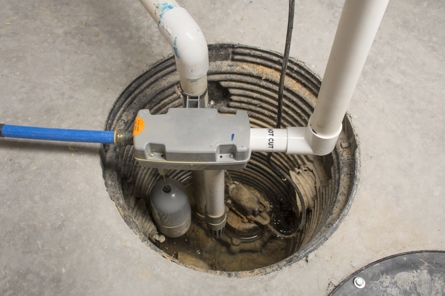Preventing Property Damage and the Role of ServiceMaster Restoration by FUSON
Water damage is a homeowner's worst nightmare, often leading to costly repairs and stress. One essential tool in preventing such situations is the sump pump, a device that can save your property from disastrous water damage.
Our team at ServiceMaster Restoration by FUSON will delve into the significance of a fully functional sump pump, the potential dangers of not having one, and how our restoration service professionals in Midland can assist if a sump pump failure or damage occurs.
What is a Sump Pump and How Does it Protect Your Home?
A sump pump is a device installed in the lowest part of your home, usually the basement, to prevent flooding. It works by collecting excess water from rain or melting snow that has seeped into your home and pumping it away from the house to a safe distance. By doing so, the sump pump prevents water buildup and keeps your basement dry, protecting your property from water damage.
The Dangers of a Poorly Functioning or Non-Operational Sump Pump
Like any other device, a sump pump can fail or malfunction due to various reasons, including:
- Power Outages: A sump pump requires electricity to function. During a power outage, the sump pump will stop working unless it's equipped with a battery backup, leaving your home vulnerable to flooding.
- Improper Installation: If a sump pump is not installed correctly, it may not operate as expected. This could include incorrect positioning, failing to seal the sump pit, or not properly connecting the pump to the drainage system.
- Lack of Maintenance: Sump pumps need regular inspection and maintenance to ensure they're in good working condition. Neglecting this can lead to problems such as a stuck float switch, clogged discharge lines, or motor burnout.
A faulty sump pump poses significant risks, such as water damage, mold growth, and other serious health hazards.
Water damage can ruin your belongings, cause structural damage to your home, and lead to expensive repairs. Additionally, standing water creates an ideal environment for mold growth, which can lead to structural decay and serious health issues like allergies and respiratory problems.
Consequences of a Malfunctioning Sump Pump
When a sump pump malfunctions, the resulting water damage can be extensive. Basement flooding is an immediate concern, damaging walls, floors, and any belongings stored there. Over time, constant exposure to moisture can weaken your home's structural integrity, leading to cracks in the foundation and walls.
Additionally, if water comes into contact with electrical outlets or appliances, it can lead to electrical hazards, posing a risk of fire or electrocution.
How to Check Your Sump Pump: A Step-By-Step Guide
A sump pump plays a crucial role in preventing basement flooding. Like any other device, it requires regular inspections to ensure optimal performance. Here's a step-by-step guide to help you inspect and test your sump pump effectively.
Step 1: Inspect the Sump Pump for Any Visible Damage
Start by visually examining your sump pump. Look for any signs of wear and tear, corrosion, or visible damage that could affect its operation. Make sure the power cord is intact and securely plugged into an outlet.
Step 2: Check for Unusual Noises or Vibrations
Next, listen for unusual noises when the pump is running. Sounds like grinding, gurgling, or loud humming could indicate problems with the motor or impeller. Similarly, if the pump vibrates excessively during operation, this could indicate damaged or worn-out parts.
Step 3: Monitor the Pump's Operation
Check if the pump runs continuously without expelling water. This could suggest a problem with the float switch, which triggers the pump to start when water reaches a certain level. If the switch is stuck or malfunctioning, the pump may run unnecessarily, leading to premature wear.
Step 4: Test the Sump Pump
Testing your sump pump is a good practice to ensure it's working correctly. To do this:
- Locate the sump pit, usually found in the basement. The pit houses the sump pump and collects excess water.
- Fill a large bucket with water and slowly pour the water into the sump pit.
- Observe the sump pump's reaction. It should automatically turn on once the water level reaches a predetermined point.
- Watch to see if the pump drains the water quickly and efficiently. Once the water level drops, the pump should automatically turn off.
Step 5: Check the Discharge Pipe
Inspect the discharge pipe, which carries water away from your home. Make sure it's not clogged with debris or frozen in colder months. The water should be discharged far enough away from your home to prevent it from seeping back into the basement.
Step 6: Consider a Professional Inspection
If you notice any issues during your inspection or are unsure about anything, consider hiring a professional. They can thoroughly inspect your sump pump, perform necessary maintenance, and recommend necessary replacements.
Following these steps can help prevent unexpected failures and protect your home from potential water damage.
ServiceMaster Restoration by FUSON: Your Partner in Property Restoration
Despite your best efforts, sump pump failures can still occur and lead to significant damage. That's where ServiceMaster Restoration by FUSON comes in. We specialize in restoring properties damaged by water, mold, and other disasters because of a malfunctioning sump pump. Our team of trained restoration professionals uses advanced techniques and equipment to remove water, dry out the area, and repair any damage, restoring your property to its pre-loss condition as quickly as possible.
Call (989) 200-5126 when experiencing property damage due to a faulty sump pump. 


